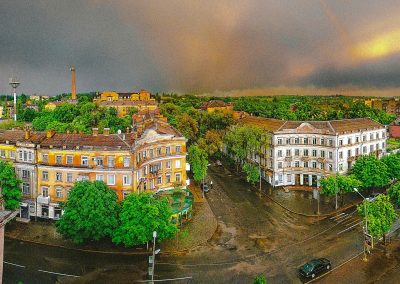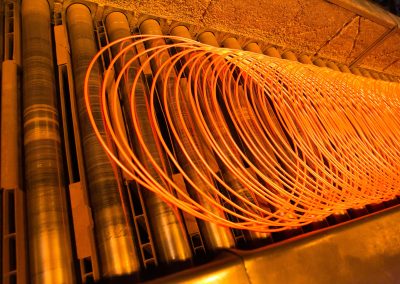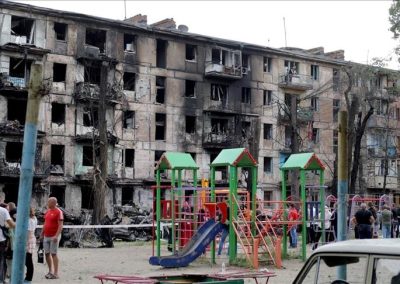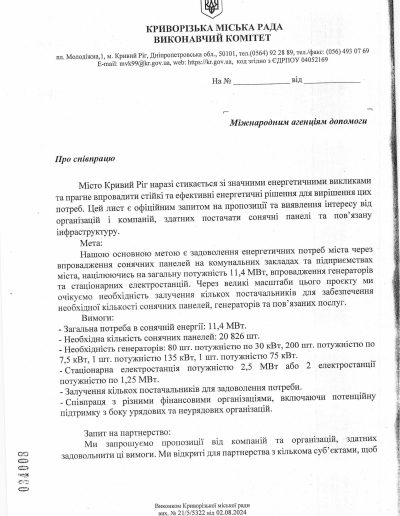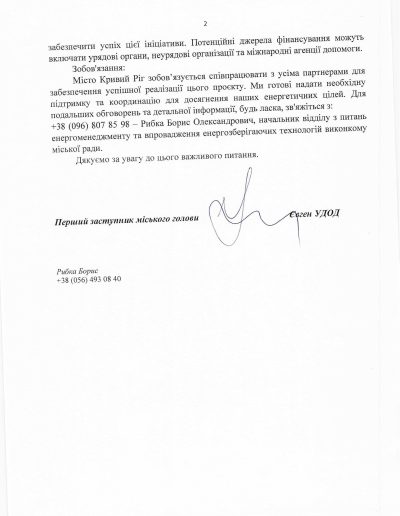Proposal for
Energy Infrastructure Resilience Support
in Kryvyi Rih, Ukraine
IN MEMORY OF THE CHILDREN WHO PERISHED IN UKRAINE
1. Executive Summary
This proposal aims to deliver a comprehensive, reliable, and scalable energy solution to Kryvyi Rih, Ukraine, by integrating solar panels and diesel generators to meet the city’s urgent energy needs. This initiative aligns with the objectives of the USAID Energy Security Project (ESP) and falls under the guidelines of the Expedited Acquisition and Assistance Procedures (EPP) for Ukraine.
The project is critical to stabilizing the energy supply for a city of one million residents (approximately 200,000 IDPs), ensuring continuous power for the city’s critical infrastructure, schools, kindergartens, municipal and other public services, and the Kryvbasvodokanal central aeration station, with the timing being of particular concern as the normally bitter and unforgiving winter is fast approaching.
2. Background and Context
Kryvyi Rih, one of Ukraine’s major industrial cities with a population of 800,000, is facing severe energy challenges due to relentless bombing that has devastated its infrastructure. The conflict has displaced over 200,000 internally displaced people (IDPs), adding to the humanitarian crisis, with many residents now homeless, orphaned, widowed, or injured. The city is struggling to meet the needs of its residents and the large influx of IDPs, further straining its already fragile resources. The city’s iron and steel industries, which are vital to the national economy, require a stable power supply to operate effectively. Additionally, residential areas and critical infrastructure, namely hospitals, kindergartens, schools, and public services, are at risk of power outages as winter approaches.
The city of Kryvyi Rih is projected to reach break-even on the investment in solar panels after approximately 6.87 years (82 months). With a solar panel cost of $8,874,620 USD and expected annual savings of $1,290,734 USD from reduced energy costs, the city will start to see a return on its investment after this period. The break-even time includes savings from providing 4 hours of solar energy per day to critical infrastructure such as schools, kindergartens, hospitals, water pumping stations, and wastewater treatment facilities.
Once the break-even point is reached, all further energy generated by the solar panels will represent additional savings, leading to significant long-term financial benefits.
The historic center of Kryvyi Rih
It was the core of the city’s formation. It is located in the area of the former confluence of the Inhulets and Saksahan rivers, and has a linear and elongated block structure.
3. Project Objectives
Primary Objective:
The primary objective is to strengthen Kryvyi Rih’s energy resilience by installing distributed hybrid solar power systems across key municipal and residential facilities currently housing internally displaced persons (IDPs) due to the ongoing conflict. Diesel generators will complement these systems to ensure a continuous power supply during peak demands and emergencies, as requested by the Deputy Mayor’s office and supervised by Mr. Boris Rybka, head of the Department for Energy Management and Implementation of Energy-saving Technologies.
Secondary Objectives:
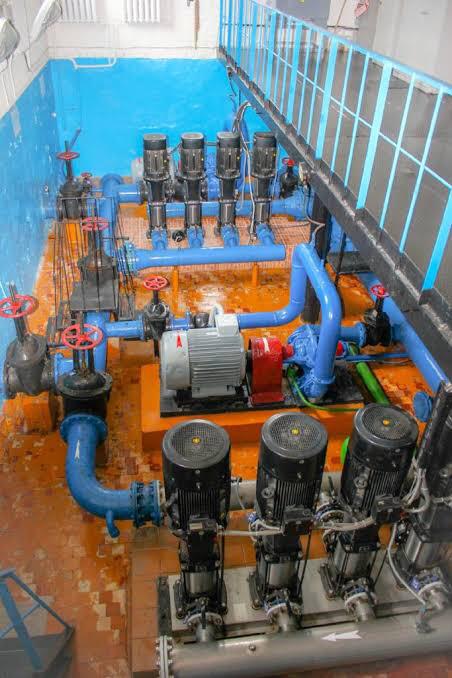
1. Water Pumping Stations of ME "Kryvbasvodokanal"
-
-
- Objective: Install hybrid solar power systems, integrated with diesel generators, at 20 pumping stations to ensure continuous water supply across the city, especially during outages.
- Purpose: These stations are vital for distributing water and maintaining water pressure for residential use and emergency services. ◦
- Impact: Ensures reliable water supply for residents and facilities housing IDPs, reducing the risk of shortages during the conflict.
-
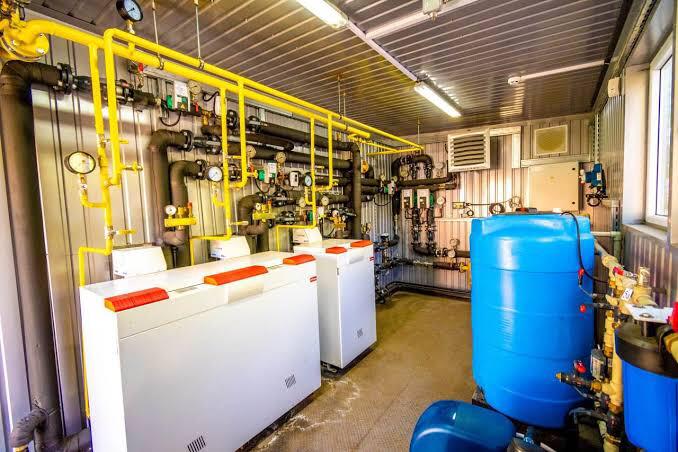
2. MEHN "Kryvorizhteplomerezha" Boiler Houses
-
-
- Objective: Equip 20 boiler houses with solar power systems to maintain uninterrupted heating during winter.
- Purpose: These boiler houses provide heat to residential and public buildings, including schools and hospitals, preventing infrastructure damage like frozen pipes.
- Impact: Reduces costly repairs and ensures the safety and warmth of displaced families and the general population during winter.
-
- Central Aeration Station of ME “Kryvbasvodokanal”:
-
- Objective: Install an 800 kW solar power system at the central aeration station to ensure continuous wastewater treatment operations.
- Purpose: The station is crucial for treating wastewater, preventing environmental contamination, and maintaining public health standards.
- Impact: Ensures effective wastewater treatment during power disruptions, safeguarding water resources and public health.
-
- Provide Reliable Power for Hospitals:
-
- Objective: Equip 5 hospitals with solar power systems to ensure continuous operation of critical medical services during outages.
- Purpose: These hospitals are currently serving dual roles in providing emergency care to war victims and treating everyday medical conditions, making a stable power supply crucial for saving lives.
- Impact: Supports approximately 24% of the city’s hospitals, ensuring they remain operational during the conflict and continue serving the population afterward.
-
- Support the Functioning of Schools and Kindergartens:
-
- Objective: Install solar power systems at 125 schools and kindergartens, many currently serving as shelters for IDPs.
- Purpose: These facilities, now housing displaced families, will eventually resume their educational roles, crucial for the city’s recovery and development.
- Impact: Covers about 42% of the city’s schools and kindergartens, ensuring a safe environment for IDPs now and, in the future, students.
-
4. Technical Solution
4.1 Distributed Solar Power Installations:
The total capacity is distributed across various locations, with the following allocations:
- 125 Schools and Kindergartens: Solar installations with power capacities of 30 kW or 40 kW, resulting in a combined capacity of 8,750 kW.
- 5 Hospitals: Solar power systems with a capacity of 40 kW each, totaling 200 kW.
- 20 Pumping Stations of ME “Kryvbasvodokanal”: Each station will receive a 40 kW solar power system, totaling 800 kW.
- 20 Boiler Houses of MEHN “Kryvorizhteplomerezha”: Solar power systems of 40 kW per site, also totaling 800 kW.
- Central Aeration Station of ME “Kryvbasvodokanal”: A dedicated 800 kW solar power system to ensure uninterrupted wastewater treatment operations.
| Category | Number of units | Power of the 1 station, kW | Total power, kW | Power of 1 panel, kW | Number of panels, pcs |
|---|---|---|---|---|---|
| Kindergartens and schools | 125 | 30 | 3,750.00 | 0.545 | 6,881 |
| Kindergartens and schools | 125 | 40 | 5,000.00 | 0.545 | 9,174 |
| Hospitals | 5 | 40 | 200.00 | 0.545 | 367 |
| Pumping stations of ME “Kryvbasvodokanal” | 20 | 40 | 800.00 | 0.545 | 1,468 |
| MEHN “Kryvorizhteplomerezha” boiler houses | 20 | 40 | 800.00 | 0.545 | 1,468 |
| Central aeration station of ME “Kryvbasvodokanal” | 1 | 800 | 800.00 | 0.545 | 1,468 |
| Total | 11,350.00 | 20,826 |
Request received on Friday, August 23, 2024, from the Head of the Department of Energy Management and Energy-Saving Technologies, Executive Committee of the Kryvyi Rih City Council.
4.2 Diesel Generator Backup:
DAS QZ-38 Generator: 34 KVA (27 KW) prime capacity, 38 KVA (30 KW) standby; fuel consumption of 7.7 liters/hour at full load. These smaller generators are intended for residential areas and smaller facilities, particularly to prevent freezing in water pipes during winter.
DAS QZ-1250 Generator: 1125 KVA (900 KW) prime capacity, 1250 KVA (1000 KW) standby; fuel consumption of 221 liters/hour at full load. These larger generators will be deployed at hospitals, critical infrastructure, and municipal facilities, ensuring uninterrupted power supply during peak loads or when solar power is insufficient.
4.3 Powering Critical Infrastructure:
Larger Generators: Allocated for hospitals, schools, emergency services, and key municipal facilities like the central aeration station. These generators are crucial for maintaining operations during power outages and protecting public health, safety, and the well-being of residents.
Smaller Generators: Deployed in residential areas and smaller critical sites, these generators prevent infrastructure damage (e.g., frozen pipes) during winter by ensuring a continuous power supply.
4.4. Implementation Strategy:
Hybrid Integration: The distributed solar power systems will meet the majority of daytime energy demands, while diesel generators will provide backup during periods of low solar production or increased demand.
Scalability: The system is designed for longevity, with solar panels expected to maintain high efficiency for 25-30 years. The distributed nature of the installations allows for future expansion and upgrades as the city’s energy needs evolve.
Location Considerations: Each site has been carefully selected based on its strategic importance, current use, and future role in the city’s recovery. The installation process will be coordinated with local authorities to minimize disruption and ensure optimal integration with existing infrastructure.
5. Financial Plan and ROI
5.1 Return on Investment (ROI) Analysis:
Fuel Cost Savings: By transitioning to solar power across critical infrastructure sites, the city is expected to save approximately $6.06 million annually in fuel costs. This savings figure reflects the reduced reliance on diesel generators, as solar panels will generate 45,600 kWh per day, offsetting the need for approximately 12,768 liters of diesel per day.
Maintenance Savings: The annual maintenance cost for the solar panels is estimated at 2% of the total installation cost. This amounts to approximately $177,492 per year for solar panels, which is significantly lower than the maintenance required for diesel generators.
Break-Even Period:
Initial Investment: The total revised cost of the project is $8,874,620, as outlined in the updated cost breakdown.
Recovery Period: With annual savings of approximately $1.29 million, the city is expected to recover the initial investment in 6.87 years. These savings are generated by reducing fuel costs for hospitals, water pumping stations, and wastewater treatment facilities, along with reduced maintenance costs for solar installations and backup diesel generators.
Long-Term Benefits:
After the break-even period, the city will continue to save $1.29 million annually for the remainder of the solar panels’ lifespan, estimated to be 25 to 30 years. Over 25 years, the cumulative savings will exceed $32 million, offering long-term financial relief.
Infrastructure Resilience:
Solar energy will enhance the resilience of Kryvyi Rih’s critical infrastructure by ensuring that essential facilities such as hospitals, schools, and water treatment plants remain operational during power outages or fuel shortages. This energy solution will improve the city’s energy security during the ongoing conflict and for future stability.
Impact on Key Facilities:
Water Treatment and Wastewater Facilities: By ensuring a consistent energy supply, solar power will prevent mechanical failures and protect public health by keeping these systems operational, particularly in preventing wastewater contamination.
Hospitals: Solar power will provide continuous electricity, ensuring that essential healthcare services remain operational, thus safeguarding patient health in both everyday and emergency situations.
Schools and Kindergartens: Currently housing IDPs, these facilities will benefit from stable electricity to improve living conditions. Solar installations will also ensure these facilities are ready to resume their educational roles, supporting the city’s long-term recovery.
To Sum Up:
The solar energy project for Kryvyi Rih provides a break-even period of 6.87 years and will save the city $1.29 million annually. The financial and operational benefits will continue for the lifespan of the solar panels, contributing to the city’s long-term energy sustainability and resilience, while also offering significant cost savings compared to diesel-generated electricity. This investment addresses critical infrastructure needs and provides a pathway toward long-term energy independence for the city.
5.2 Cost Breakdown Table for 11.4 MW Hybrid Solar Power System
| Item Description | Quantity | Unit price | Total Cost |
|---|---|---|---|
| Monocrystalline Solar Panels – (540W) Dimensions: 2279 x 1134 x 35mm 27.8kg panel weight |
21120 | $154 | $3,252,480 |
| ARCLK – INV 50 KT – PRO Inverter | 295 | $3500 | $1,032,500 |
| ARCLK – INV 100 KT – PRO Inverter | 8 | $6985 | $55,880 |
| Installing Solar panels Cabling, control panels Labor cost The installation angle is at 40° to the horizon Ballasted Mounting Systems Construction vehicles needed: truck-mounted cranes |
21120 | $198 | $4,181,760 |
| Diesel Generators – DAS QZ-38 (35 kVA) Standby Power: 38 kVA Prime Power: 32 kVA Motor: QUARTZ Alternator: STAMFORD-LEROY SOMER |
80 | $3200 | $256,000 |
| Diesel Generators – DAS-PR-7.5/1 (7.5 kVA) Standby Power: 8.5 kVA Prime Power: 7 kVA Motor: DAS |
200 | $680 | $136,000 |
| Diesel Generators – DAS-PR-101 (101 kVA) Standby Power: 112 kVA Prime Power: 101 kVA Motor: QUARTZ Alternator: DAS |
10 | $950 | $9,500 |
| Diesel Generators – DAS QZ-1250 (1250 kVA) Standby Power: 1250 kVA Prime Power: 1125 kVA Motor: QUARTZ Alternator: STAMFORD-LEROY SOMER |
2 | $60,000 | $120,000 |
| Diesel Generators – DAS QZ-PH-175 (175 kVA) Standby Power: 160 kVA Prime Power: 160 kVA Motor: QUARTZ Alternator: STAMFORD-LEROY SOMER |
1 | $8,000 | $8,000 |
| Diesel Generators – DAS QZ-PH-105 (105 kVA) Standby Power: 105 kVA Prime Power: 95 kVA Motor: QUARTZ Alternator: STAMFORD-LEROY SOMER |
1 | $6,500 | $6,500 |
| Logistics Costs for Solar panels (by trucks) Goods insurance is covered until the Romanian-Ukrainian border Each truck can carry up to 3712 solar panels Inverters can be fit in one truck |
63 | $4,000 | $252,000 |
| Logistics Costs for Generators (by trucks) | 6 | $4,000 | $24,000 |
| Subtotal | $9,334,620 | ||
| Monitoring, quality control, and assurance (4%) | $373,385 | ||
| Contingency (5%) | $466,731 | ||
| Total | $10,174,736 |
* the export is exempt from Turkish VAT
* the total cost does NOT include Ukrainian VAT
* global insurance companies CANNOT insure goods in conflict zones; the goods are under Kryvyi Rih authorities’ supervision inside the territory of Ukraine from the Ukraine-Romania border to the city of Kryvyi Rih
5.3 Cost-Effectiveness and Competitive Advantage
Competitive Pricing Analysis
Our proposal for the 11.4 MW solar installations across critical infrastructure in Kryvyi Rih is strategically priced to deliver exceptional value while ensuring reliable energy for essential services like hospitals, water treatment facilities, and schools housing IDPs. The project is priced well below global market rates and competitor pricing, providing an excellent return on investment while addressing the city’s immediate energy needs in a conflict zone.
Market Comparison
Global industry-standard costs for solar power installations range between $1.5 million and $2 million per MW. This means a typical 11.4 MW project would cost between $17.1 million ve $22.8 million. However, our proposal offers the same capacity at a cost of $8.9 million, which is almost half the market average. [Read more]
Moreover, as highlighted by recent projects like the 240 MW Pokrovska solar power plant developed by DTEK in 2019, the cost per MW was approximately €804,167 or $884,584 USD. Adjusted for inflation to 2024, this equates to roughly €931,270 or $1,050,835 USD per MW. In contrast, our cost per MW remains highly competitive, further emphasizing our commitment to cost-efficiency. [Read more]
| Category | Global Market Standard (Estimated) | DTEK Pokrovska Project (Adjusted to 2024) | This Proposal |
|---|---|---|---|
| Cost per MW | $1.5M – $2M USD | €931,270 (~$1.05M USD) | $847,667 |
| Total Cost for 11.4 MW | $17.1M – $22.8M USD | €10.6M (~$12M USD) | $8,874,620 |
| Break-Even Period | 5-7 years | N/A | 6.87 years (82 months) |
| Cost Advantage | – | ~10-15% lower than industry average | ~43% lower than industry average |
Comparing with Competitors
We have also conducted a detailed analysis of similar projects across the region. For instance, standard industry prices for solar installations in Ukraine, as well as other Eastern European countries, consistently show higher per-MW costs compared to our proposal. [See Appendix] By working with our carefully selected partners and suppliers, we have managed to lower costs and pass those savings directly to the city of Kryvyi Rih.
5.4 Contingency Plan for the Kryvyi Rih Energy Project
Given the complex and volatile environment in Ukraine, due to the ongoing conflict with
Russia, the Kryvyi Rih Energy Project requires a robust contingency plan to mitigate potential risks
that could impact the project’s timeline, budget, and overall success. This contingency plan
addresses specific concerns related to the war, approaching winter, and road conditions, and
aligns with USAID guidelines to ensure the project’s resilience in the face of unforeseen challenges.
The purpose of this contingency plan is to allocate additional resources to address unexpected
challenges that may arise during the project’s implementation, including:
- Security risks associated with the ongoing conflict.
- Harsh winter conditions that could affect logistics and installation.
- During the cold seasons, the higher demand for diesel generators typically leads to delays and increased prices.
- Inflation in both the Turkish Lira and the US Dollar, alongside the fluctuation in the USD to Turkish Lira exchange rate.
- Poor road conditions or damage to infrastructure may delay the transportation of materials.
- Incorrect handling of goods, especially solar panels and especially from the Ukraine-Romania border to Kryvyi Rih which cannot be covered by insurance.
Requested Contingency plan: 5% of the total project cost, amounting to $466,731.
Risk Identification and Mitigation Strategies:
| Risk | Mitigation Plan | |
|---|---|---|
| Security Risks | Escalation of conflict near the project site, leading to delays or halts in construction. |
Coordination with local authorities and security consultants to monitor the situation and adapt the project schedule as needed. Implementing flexible work plans that allow for rapid rescheduling or relocation of activities if the security situation deteriorates. Allocating part of the contingency plan for enhanced security measures for high-value shipments. |
| Winter Conditions | Severe winter weather that could hamper transportation, construction, and installation of solar panels and generators. |
Coordination with local authorities and security consultants to monitor the situation and adapt the project schedule as needed. Implementing flexible work plans that allow for rapid rescheduling or relocation of activities if the security situation deteriorates. Allocating part of the contingency plan for enhanced security measures, such as armed escorts for high-value shipments. |
| Road Conditions and Infrastructure | Damaged or poorly maintained roads either inside the Ukrainian territory or en route, leading to transportation delays or increased costs. |
Conducting thorough route assessments prior to transportation to identify and plan for potential hazards. Securing alternate transportation routes or methods (e.g., rail or air transport) that can be activated if primary routes are compromised. Utilizing the contingency plan to cover additional logistics costs if rerouting or expedited shipping becomes necessary. |
Implementation and Monitoring: Contingency plan Management: The contingency plan will be managed by the project’s financial team, with expenditures requiring approval from the project director. Detailed records will be kept of all contingency plan uses, with regular reports submitted to USAID.
Monitoring and Adjustment: The project team will continuously monitor the security situation, weather forecasts, and road conditions, adjusting the project plan as necessary to mitigate emerging risks. Regular risk assessments will be conducted, and the contingency plan will be updated accordingly. The inclusion of a 5% contingency plan is essential for ensuring the project’s success in the challenging environment of Ukraine. This allocation is consistent with USAID’s guidelines on risk management and is critical for addressing the unique risks posed by the ongoing conflict, severe winter weather, and infrastructure challenges. By proactively planning for these risks, the project team aims to minimize disruptions, maintain the project timeline, and ensure that the objectives of providing reliable energy to Kryvyi Rih are met.
6. Implementation Plan
Phase 1: Planning and Coordination (Already Completed ✅)
Meetings with Ukrainian Officials: Conducted meetings with Ukrainian officials in Kryvyi Rih on July 26 and July 29, 2024, to finalize the project scope and secure the necessary approvals.
Official Letter of Intent: Successfully obtained the official letter of intent, confirming the city’s commitment to the project.
Phase 2: Initial Preparations (Generators are priority)
Focus: Procurement and logistics for diesel generators and initial solar panel production.
Key Activities:
Diesel Generator Procurement: $536,000 allocated.
Generator Logistics: $24,000 for transportation.
Initial Solar Panel Production: $1,200,000.
Solar Panel Installation and Delivery: $290,000 ($150,000 & $140,000).
Total Cost for Phase 2: $2,318,240 (+ $200,000 advance payment for phase 3)
Phase 2 |
Sep 2024 21st – 30th |
Oct 2024 1st – 10th |
Oct 2024 11th – 20th |
Oct 2024 21st – 31st |
|---|---|---|---|---|
| Solar Panel Advance Payment(s) | $200,000 | $200,000 | ||
| Solar Panel Production | $1,000,000 | |||
| Solar Panel Installation and Delivery | $150,000 | $140,000 | ||
| Solar Panel Logistics | $26,000 | $30,000 | ||
| Diesel Generator | $268,000 | $268,000 | ||
| Generator Logistics | $24,000 | |||
| Total Supply Costs | $468,000 | $1,668,000 | $170,000 | |
| Operations Management and Quality Control | $18,720 | $66,720 | $6,800 | |
| Contingency | $120,000 | |||
| Total | $486,720 | $0 | $1,854,720 | $176,800 |
This phase emphasizes securing and transporting diesel generators while beginning the production and installation of solar panels.
Phase 3: Generator Delivery and Starting Solar Panel Transportation
Focus: Ensuring all diesel generators are manufactured and delivered before winter and beginning solar panel production.
Key Activities:
Diesel Generator Delivery: Generators are fully delivered, preparing for winter.
Solar Panel Shipment: Start delivering the already manufactured solar panels to Ukraine.
Solar Panel Installation and Delivery: allocated across this phase.
Logistics: $56,000 allocated for solar panel transportation.
Contingency: $100,000 set aside for unforeseen issues, especially for the first solar panel overland transportation.
Total Cost for Phase 3: $1,707,840 (+ $200,000 advance payment for phase 4)
Phase 3 |
Oct 2024 11th – 20th |
Oct 2024 21st – 31st |
Nov 2024 1st – 10th |
Nov 2024 11th – 20th |
|---|---|---|---|---|
| Solar Panel Advance Payment(s) | $200,000 | $200,000 | ||
| Solar Panel Production | $1,000,000 | $1,000,000 | ||
| Solar Panel Installation and Delivery | $150,000 | $140,000 | $150,000 | $140,000 |
| Solar Panel Logistics | $26,000 | $30,000 | $26,000 | $30,000 |
| Diesel Generator | $268,000 | |||
| Generator Logistics | $24,000 | |||
| Total Supply Costs | $1,668,000 | $170,000 | $1,376,000 | $170,000 |
| Operations Management and Quality Control | $66,720 | $6,800 | $55,040 | $6,800 |
| Contingency | $120,000 | $100,000 | ||
| Total | $0 | $0 | $1,431,040 | $276,800 |
This phase is crucial for ensuring that all necessary equipment is in place before winter, with a focus on logistics and initial solar panel installation.
Phase 4: Solar Panel Installation
Focus: Begin installation of solar panels.
Key Activities:
Solar Panel Production: Significant production ramp-up for both November and December.
Solar Panel Installation and Delivery: Intensive installation phase with more delivery
Solar Panel Logistics: Continued transportation efforts with $56,000 allocated for logistics. (For 14 trucks to carry approximately 2 MW of solar panels and necessary equipment)
Operations Management and Quality Control: Ensuring smooth operations with $61,840 allocated for quality control.
Contingency: $100,000 reserved for unforeseen challenges.
Total Cost for Phase 4: $1,707,840 (+ $200,000 advance payment for phase 5)
Phase 4 |
Nov 2024 1st – 10th |
Nov 2024 11th – 20th |
Nov 2024 21st – 30th |
Dec 2024 1st – 10th |
Dec 2024 11th – 20th |
|---|---|---|---|---|---|
| Solar Panel Advance Payment(s) | $200,000 | $200,000 | |||
| Solar Panel Production | $1,000,000 | $1,000,000 | |||
| Solar Panel Installation and Delivery | $150,000 | $140,000 | $150,000 | $140,000 | |
| Solar Panel Logistics | $26,000 | $30,000 | $26,000 | $30,000 | |
| Diesel Generator | |||||
| Generator Logistics | |||||
| Total Supply Costs | $1,376,000 | $170,000 | $1,376,000 | $170,000 | |
| Operations Management and Quality Control | $55,040 | $6,800 | $55,040 | $6,800 | |
| Contingency | $100,000 | $100,000 | |||
| Total | $0 | $1,431,040 | $276,800 |
This is a crucial phase where the majority of the solar panel installations are carried out, laying the foundation for the project’s successful completion.
Phase 5: Solar Panel Installation and Delivery Continues
Focus: Continue production, transportation, and installation of solar panels.
Key Activities:
Solar Panel Production: Continue production with $1,000,000 allocated.
Solar Panel Installation and Delivery: Installation continues
Solar Panel Logistics: Continued transportation efforts with $56,000 allocated for logistics. (For 14 trucks to carry approximately 2 MW of solar panels and necessary equipment)
Operations Management and Quality Control: Oversee the delivery and installation phase with $61,840 allocated for quality control.
Contingency: $100,000 reserved for any unforeseen issues during the final phase.
Total Cost for Phase 5: $1,707,840 (+ $200,000 advance payment for phase 6)
Phase 5 |
Dec 2024 1st – 10th |
Dec 2024 11th – 20th |
Dec 2024 21st – 31st |
Jan 2025 1st – 10th |
|---|---|---|---|---|
| Solar Panel Advance Payment(s) | $200,000 | $200,000 | ||
| Solar Panel Production | $1,000,000 | $1,000,000 | ||
| Solar Panel Installation and Delivery | $150,000 | $140,000 | $150,000 | $140,000 |
| Solar Panel Logistics | $26,000 | $30,000 | $26,000 | $30,000 |
| Diesel Generator | ||||
| Generator Logistics | ||||
| Total Supply Costs | $1,376,000 | $170,000 | $1,376,000 | $170,000 |
| Operations Management and Quality Control | $55,040 | $6,800 | $55,040 | $6,800 |
| Contingency | $100,000 | |||
| Total | $0 | $1,431,040 | $276,800 |
This phase marks the final major efforts in delivering and installing solar panels, ensuring that the project’s solar energy infrastructure is fully operational by the end of the year.
Phase 6: Solar Panel Installation and Delivery Continues
Focus: Complete all remaining installations, finalize logistics, and ensure project completion.
Key Activities:
Solar Panel Production: Continue production with $1,000,000 allocated.
Solar Panel Installation and Delivery: Installation continues
Solar Panel Logistics: Continued transportation efforts with $56,000 allocated for logistics. (For 14 trucks to carry approximately 2 MW of solar panels and necessary equipment)
Operations Management and Quality Control: Oversee the delivery and installation phase with $61,840 allocated for quality control.
Total Cost for Phase 6: $1,607,840 (+ $200,000 advance payment for phase 7)
Phase 6 |
Dec 2024 21st – 31st |
Jan 2025 1st – 10th |
Jan 2025 11th – 20th |
Jan 2025 21st – 31st |
|---|---|---|---|---|
| Solar Panel Advance Payment(s) | $200,000 | $200,000 | ||
| Solar Panel Production | $1,000,000 | $1,000,000 | ||
| Solar Panel Installation and Delivery | $150,000 | $140,000 | $150,000 | $140,000 |
| Solar Panel Logistics | $26,000 | $30,000 | $26,000 | $30,000 |
| Diesel Generator | ||||
| Generator Logistics | ||||
| Total Supply Costs | $1,376,000 | $170,000 | $1,376,000 | $170,000 |
| Operations Management and Quality Control | $55,040 | $6,800 | $55,040 | $6,800 |
| Contingency | ||||
| Total | $0 | $1,431,040 | $176,800 |
This phase marks the conclusion of the project, ensuring all solar panels are installed, logistics are finalized, and any remaining tasks are completed to ensure the successful wrap-up of the project.
Phase 7: Finalization and Project Wrap-Up
Focus: Complete all remaining installations, finalize logistics, and ensure project completion.
Key Activities:
Solar Panel Production: Final production efforts with $643,000 allocated.
Solar Panel Installation and Delivery: Complete installations with $244,000 allocated.
Operations Management and QC: Oversee the final stage with $35,480 allocated.
Contingency: $40,000 reserved for any last-minute issues.
Total Cost for Phase 7: $1,123,642
Phase 7 |
Jan 2025 11th – 20th |
Jan 2025 21st – 31st |
Feb 2025 1st – 10th |
Feb 2025 11th – 20th |
|---|---|---|---|---|
| Solar Panel Advance Payment(s) | $200,000 | |||
| Solar Panel Production | $1,000,000 | $605,656 | ||
| Solar Panel Installation and Delivery | $150,000 | $140,000 | $204,000 | |
| Solar Panel Logistics | $26,000 | $30,000 | $20,000 | $20,000 |
| Diesel Generator | ||||
| Generator Logistics | ||||
| Total Supply Costs | $1,376,000 | $170,000 | $829,656 | $20,000 |
| Operations Management and Quality Control | $55,040 | $6,800 | $33,186 | $800 |
| Contingency | $100,000 | $40,000 | ||
| Total | $0 | $0 | $902,842 | $20,800 |
This phase continues the solar panel production, installation, and final logistics, preparing the project for completion in early 2025.
Phase 8 (Proposed): Project Expansion and Scalability Planning
Focus: Assess opportunities for expanding the existing solar power infrastructure to further enhance energy security in Kryvyi Rih and potentially neighboring regions.
Key Activities:
Feasibility Study: Conduct a comprehensive feasibility study to evaluate the potential for scaling up the solar power capacity beyond the initial 11.4 MW, possibly adding 5-10 MW.
Benefactors’ Engagement: Engage with local authorities, industry leaders, and international partners to gauge interest and secure additional funding or partnerships for the expansion.
Technical Assessment: Assess the existing infrastructure to determine what upgrades or expansions might be necessary to support increased capacity, including additional solar
panels, inverters, and storage solutions.
Budget Planning: Prepare a detailed budget and ROI analysis for the proposed expansion, estimating costs, expected savings, and the timeline for implementation.
Total Cost Estimate: TBD based on the outcomes of the feasibility study and stakeholder engagement.
Potential Benefits:
Increased Energy Security: Further reduce reliance on fossil fuels by increasing the share of renewable energy in the city’s energy mix.
Economic Growth:
Create additional jobs and attract more investment in the region.
Regional Impact: Keeps Kryvyi Rih’s position as an industry hub with the help of renewable energy, potentially expanding the benefits to neighboring cities and regions.
7. Partnerships and Organizers
Key Partners:
Zafer Erciyas: Representative of energy factories.
Hannah Namestnik: Ukrainian Coordinator and Liaison.
Kasra Sharifan: Facilitator and internatiomnal aid coordinator.
8. Closing Remarks
This proposal presents a robust, scalable solution to the energy challenges facing Kryvyi Rih, Ukraine. By integrating solar power with diesel generators, the project addresses both immediate and mid-term energy needs, ensuring a stable power supply as the city prepares for winter. The
investment in this hybrid energy system is not only a response to the current crisis but a strategic move towards sustainable energy security in Ukraine. We seek the support of USAID, The European Bank for Reconstruction and Development (EBRD), the US Department of State, and all other aiding agencies to make this vision a reality, delivering essential power infrastructure to a city in urgent need.
Appendix
Targeted locations in Kryvyi Rih:
1. Pumping Stations of ME “Kryvbasvodokanal”
Purpose: These pumping stations are part of Kryvbasvodokanal, the municipal water utility responsible for providing water and managing wastewater in Kryvyi Rih. The pumping stations are critical for ensuring that water is transported from sources (like rivers or reservoirs) to treatment facilities and then distributed to residential, commercial, and industrial areas.
Role in the Project: The solar panels will help power these stations, ensuring a reliable water supply even during power outages, which is particularly important during the war when infrastructure is vulnerable.
2. MEHN “Kryvorizhteplomerezha” Boiler Houses
Purpose: Kryvorizhteplomerezha is the municipal enterprise responsible for providing heating services to residential, commercial, and public buildings in Kryvyi Rih. The boiler houses are facilities where water is heated to produce steam or hot water, which is then distributed through a network of pipes to heat buildings during the cold months.
Role in the Project: By installing solar panels, these boiler houses can ensure continued operation even if the main power grid is compromised, helping to maintain heating in the city’s buildings, which is crucial during winter.
3. Central Aeration Station of ME “Kryvbasvodokanal”
Purpose: The central aeration station is a key component of the wastewater treatment process managed by Kryvbasvodokanal. Aeration stations introduce air into wastewater to promote the growth of beneficial microorganisms that break down organic matter. This is a critical step in treating wastewater before it is discharged back into the environment or reused.
Role in the Project: The solar power system will ensure that this aeration station continues to operate effectively, even during power disruptions, thus maintaining essential wastewater treatment processes.
Economic Portfolio of Kryvyi Rih (Energy focused):
Kryvyi Rih, located in the Dnipropetrovsk Oblast of central Ukraine, is an industrial giant, particularly known for its vast reserves of iron ore. This mining and metallurgical hub is crucial to Ukraine’s economy, contributing significantly to the national GDP. However, the city’s industrial activities are energy-intensive, making energy security a critical component of its economic stability. Ukraine’s Energy Strategy 2035: Ministry of Energy and Coal Industry of Ukraine.
4 Economic and Industrial Reports: State Statistics Service of Ukraine, 2023. Kryvorizhstal Production Data: Metinvest Holding LLC, 2022. Renewable Energy Potential Reports: National Academy of Sciences of Ukraine, 2023.
For more information, visit:
- Ukraine’s Energy Strategy 2035: Ministry of Energy and Coal Industry of Ukraine.
- Economic and Industrial Reports: State Statistics Service of Ukraine, 2023.
- Kryvorizhstal Production Data: Metinvest Holding LLC, 2022.
- Renewable Energy Potential Reports: National Academy of Sciences of Ukraine, 2023.
1. Industrial Powerhouse:
Iron Ore Production: Kryvyi Rih is home to one of the largest iron ore deposits in the world. The city’s mining industry produces over 70 million tons of iron ore annually, accounting for 42% of Ukraine’s total production. The Kryvorizhstal steel plant, one of the largest in Eastern Europe, produces over 6 million tons of steel per year.
Economic Contribution: The mining and metallurgical industries in Kryvyi Rih contribute approximately 8-10% of Ukraine’s GDP, employing around 20% of the city’s workforce.
2. Energy Consumption:
High Energy Demand: The city’s industrial base consumes approximately 7-8 TWh (terawatthours) of electricity annually. The Kryvorizhstal steel plant alone accounts for a significant portion of this, requiring a constant and reliable power supply to maintain its operations.
Current Energy Sources: Historically, Kryvyi Rih has relied on coal, natural gas, and imported electricity, making it vulnerable to supply disruptions and price fluctuations.
3. Challenges in Energy Supply:
Conflict Impact: The ongoing conflict in eastern Ukraine has severely impacted energy infrastructure, with attacks on power lines and facilities causing frequent outages. This instability has led to a 15-20% increase in energy costs for industrial users in the region over the past few years.
Energy Deficit: The city faces an energy deficit, particularly during peak winter months, which threatens the continuity of industrial operations and the stability of the residential energy supply.
4. Renewable Energy Potential:
Solar Energy Opportunity: Kryvyi Rih is well-positioned to harness solar energy, with an average of 2,000-2,100 hours of sunshine per year. This solar potential can be leveraged to generate up to 1.5 GW (gigawatts) of electricity annually if fully developed.
Current Projects: The city has seen initial investments in solar energy, with small-scale solar farms contributing approximately 100 MW to the local grid. However, there is significant untapped potential for expansion.
5. Economic Impact of Energy Investments:
Cost Savings: Transitioning to solar energy could save the city $30-50 million annually in fuel costs alone, depending on the scale of adoption. This is particularly relevant given the rising costs
of fossil fuels and the instability of supply chains.
Job Creation: Developing a robust renewable energy sector in Kryvyi Rih could create 5,000-7,000 jobs in construction, maintenance, and operations, further boosting the local economy.
Attracting Investment: A shift towards renewable energy makes the city more attractive for foreign investment, particularly from European Union countries that are increasingly focusing on green energy projects.
6. Future Outlook:
Long-Term Energy Strategy: The city’s long-term energy strategy includes plans to increase the share of renewable energy to 30-40% of total consumption by 2030. This would involve expanding solar capacity to over 500 MW and integrating it with battery storage and smart grid technologies to ensure reliability.
Economic Resilience: By diversifying its energy sources and reducing reliance on imported fuels, Kryvyi Rih can strengthen its economic resilience. This will not only support its industrial base but also stabilize energy costs for both businesses and residents.
Why NOT Wind Energy in Kryvyi Rih
The wind speeds in Kryvyi Rih, Ukraine, generally range between 2.2 and 13.4 mph (3.5 to 21.6 km/h), with occasional gusts reaching up to 24.5 mph (39.4 km/h). The prevailing wind direction is from the northeast. On average, wind conditions in Kryvyi Rih can be classified as moderate, with the majority of days experiencing light to moderate breezes. These data points reflect consistent seasonal variations, with slightly stronger winds in the colder months.
For wind energy generation to be viable, sustained wind speeds of at least 10-15 mph (16-24 km/ h) are generally required for smaller-scale wind turbines and 15-25 mph (24-40 km/h) for larger turbines to operate efficiently. Industrial-scale wind farms, particularly, demand even higher consistent speeds to maximize output and return on investment. At speeds lower than these thresholds, wind turbines do not generate sufficient power to justify the installation and operational costs.
Based on the wind data for Kryvyi Rih, wind speeds fall below the optimal range for efficient wind energy production, especially on a large scale. The region’s wind conditions are inconsistent and too weak for cost-effective energy generation using wind turbines. Consequently, we believe that wind energy is not a feasible renewable energy option for Kryvyi Rih or similar regions in Ukraine, especially when compared to more consistent renewable sources like solar power. Given the moderate wind speeds, focusing on solar installations, which have proven reliable, is a more pragmatic and beneficial approach for energy resilience.
Why Türkiye?
Unified Criteria for Cost Comparison:
Scope: The cost includes solar panels, inverters, installation, and transformers, excluding additional components like diesel generators.
Cost Factors: Transportation, logistics, and potential customs duties are considered.
Currency Conversion: Costs are converted to USD for uniformity.
Cost per Watt Calculation for Turkey
Turkey:
Total Cost for 11.4 MW System: $8,474,140 USD
System Capacity: 11,400 kW
Cost per Watt =11,400 kW8,474,140 USD ≈ 0.74 USD per watt
Cost per Watt Calculation for Other Countries
1. Poland:
Estimated Total Cost: $0.85 to $0.95 USD per watt, including all factors.
Justification: Higher labor costs and slightly higher equipment prices.
2. Hungary:
Estimated Total Cost: $0.82 to $0.88 USD per watt.
Justification: Similar logistics costs to Poland but slightly lower labor and material costs.
3. Romania:
Estimated Total Cost: $0.80 to $0.85 USD per watt.
Justification: Slightly lower costs due to proximity to Ukraine and potentially lower labor costs compared to Poland and Hungary.
Regional Competitors’ Quadrant:

Final Comparison Table
| Country | Cost per Watt (USD) | Notes |
|---|---|---|
| Turkey | $0.74 | Competitive pricing, including logistics to Ukraine. |
| Poland | $0.85 – $0.95 | Higher labor costs and quality are considered high. |
| Hungary | $0.82 – $0.88 | Moderate labor and logistics costs. |
| Romania | $0.80 – $0.85 | Lower labor costs, proximity advantage. |
In Short:
Turkey emerges as the most cost-effective option, with a cost of $0.74 USD per watt. Romania follows closely with a range of $0.80 to $0.85 USD per watt but with potential quality considerations and logistical advantages.
Poland and Hungary are slightly more expensive, with costs ranging from $0.82 to $0.95 USD per watt.
Consideration in the calculations:
To determine whether this assessment is fair, let’s consider several factors:
1. Cost Assumptions:
The cost-per-watt estimates provided for Poland, Hungary, and Romania are based on general industry knowledge and logical assumptions about labor, material, and logistics costs. However, without specific quotes or detailed market research, these numbers are broad estimates rather than precise figures.
2. Quality and Reliability:
The assessment mentions quality differences, particularly between Turkish and Polish products, but doesn’t provide a detailed analysis. Quality can significantly impact long-term performance and maintenance costs, so this factor should be carefully weighed.
3. Logistics and Proximity:
Turkey has a unique logistical advantage due to its strategic relationship with both Ukraine and Russia, which reduces the likelihood of disruptions to shipments, particularly in conflict zones. This advantage may minimize the risk of Turkish ships being harassed, ensuring smoother transportation routes. Additionally, Romania’s proximity to Ukraine might reduce logistics costs, but exact savings depend on transportation routes, fuel prices, and border regulations.
4. Market Dynamics:
The solar industry is influenced by factors such as supply chain disruptions, tariffs, and currency fluctuations. These can cause significant price variations, which should be considered in the assessment.
5. Vendor Relationships and Negotiation:
Prices can often be negotiated, especially for large orders like an 11.4 MW system. Building strong vendor relationships might allow for better pricing or terms, which hasn’t been explicitly factored into the cost comparisons.
ROI Calculations and Assumptions:
Here’s a detailed step-by-step process of how we reached the ROI figures for the Kryvyi Rih Energy Project:
Peak Sun Hours Assumption at 4 hours a day.
It is logical to assume 4 hours per day as a conservative estimate for peak solar power output in Kryvyi Rih. The distinction between daylight hours and peak sun hours is key here:
Daylight Hours: Kryvyi Rih, like most locations in Ukraine, can experience anywhere from 8 hours of daylight in winter to up to 16 hours in summer.
Peak Sun Hours: These are the hours when sunlight is strong enough to generate maximum electricity. Even with long daylight hours, the intensity of sunlight is lower in the early morning and late afternoon, so solar panels are not working at full capacity throughout the entire day. Peak sun hours typically occur around midday, when the sun is at its highest and strongest.
In Ukraine, peak sun hours range from 3.5 to 4.5 hours per day on average, depending on the season and weather conditions. By using 4 hours per day for solar calculations, we ensure we are making a safe and reliable assumption that accounts for both seasonal variability and real-world inefficiencies, such as cloud cover or shading.
Step 1: Establish the Total Project Cost
Total Cost: The total cost of the project is now $8,874,620, based on updated cost breakdowns including the cost of solar panels, diesel generators, logistics, and contingency.
Step 2: Estimate the Annual Savings Current Fuel Costs:
Kryvyi Rih relies heavily on diesel generators, especially during outages and peak demand. The price of diesel in Ukraine (2024) averages around 54.58 UAH/liter (~$1.30 USD/liter).
Fuel Consumption: Generator Efficiency: Large diesel generators, like the DAS QZ-1250, consume 250 liters/hour at
full load.
Annual Fuel Consumption: Daily fuel consumption (assuming 12 hours of daily operation): 250 liters/hour
250 liters/hour×12 hours/day=3,000 liters/day
Annual fuel consumption: 3,000
3,000 liters/day×365 days/year=1,095,000 liters/year
Fuel Cost Savings:
1,095,000 liters/year×1.30 USD/liter=1,423,500 USD/year
Reference:
Diesel Price Data: Based on the Ministry of Energy of Ukraine, 2024 report.
Fuel Consumption Rates: Manufacturer specifications for DAS QZ-1250 generators.
Solar Panel Efficiency: Data from the International Renewable Energy Agency (IRENA) on long-term solar panel performance.
Local Market Analysis: Sourced from the Ukrainian Solar Energy Association’s 2023 Annual Report.
Solar Contribution:
Solar panels are expected to reduce diesel reliance by 33.3% (replacing 4 hours of diesel usage daily). This leads to annual fuel cost savings of approximately:
1,423,500×0.333=474,025.50 USD/year saved
Step 3: Determine the Break-Even Period for Solar Panels
Initial Investment: $8,874,620 USD Annual Savings (Fuel + Maintenance): Approximately $1,290,734 USD/year. Break-Even Period Calculation:
Break-even period= $8,874,620 / $1,290,734 ≈ 6.87 years (82months)
Step 4: Calculate Long-Term Benefits
Lifespan of Solar Panels: Solar panels typically last 25 to 30 years.
Post-Break-Even Savings: Once the break-even period is reached, the city will continue to save approximately $1.29 million per year in fuel and maintenance costs.
Step 5: Assumptions and References
Assumption 1: Diesel fuel prices remain stable or increase modestly, following
historical trends.
Assumption 2: Solar panel efficiency decreases by only 0.5% per year, a common industry standard, ensuring continued high performance.
Assumption 3: Maintenance costs for solar panels remain low due to minimal
moving parts and routine cleaning.
ROI Summary Table
| Category | Amount (USD) | Notes |
|---|---|---|
| Total Solar Panel Cost | $8,874,620 | Includes solar panels, diesel generators, logistics, installation, and contingency. |
| Annual Fuel Cost Savings | $474,025 | Resulting from reduced reliance on diesel generators due to solar panel integration for 4 hours a day. |
| Maintenance Cost (Annual) | $177,492 | Estimated at 2% of the total solar power system installation cost. |
| Break-Even Period | 6.87 years (82 months) | Time required to recover the initial investment based on fuel cost savings and maintenance reductions. |
| Long-Term Savings (25 years) | $149.9 million | Post break-even savings from reduced fuel costs and maintenance over the 25-year lifespan of the solar panels. |
| Contingency Fund | $460,000 | 5% of the total project cost, allocated for unforeseen challenges. |
6 Lifespan of Solar Panels: Expected to be 25-30 years, with approximately 80-85% efficiency retained after 25 years.
